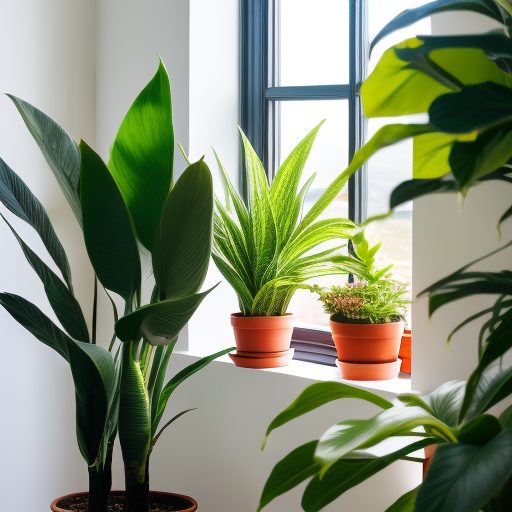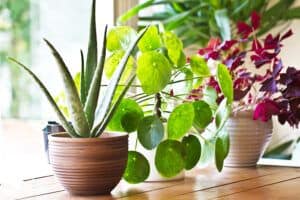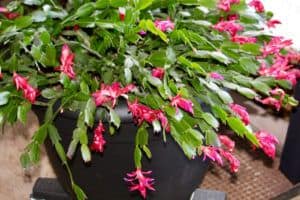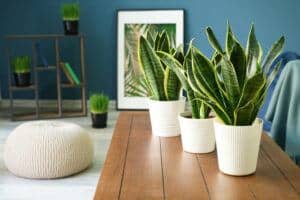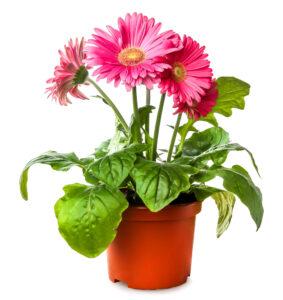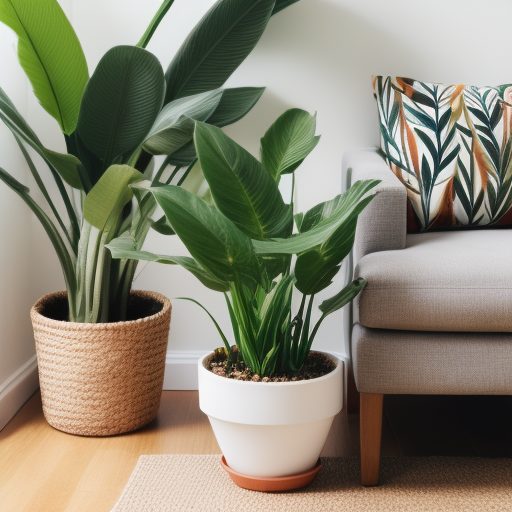HousePlantJoy is supported by our audience. When you purchase through one of our links, we may earn a small affiliate commission. As an Amazon Associate I earn from qualifying purchases. Your cost is not affected.
==================
Welcome to the vibrant universe of sun-loving houseplants, where the beauty of nature meets the coziness of your home. If you’ve ever wondered which green companions thrive in the warm embrace of direct sunlight, you’re in the right place. In this guide, we’ll explore a variety of sun-loving houseplants that not only add a touch of the outdoors to your indoor spaces but also bring a breath of fresh air to your home decor.
Just like us, plants have their preferences, and sun-loving houseplants are no exception. These botanical wonders not only revel in the sunlight but also have unique characteristics that make them a delight to care for. From the resilient Jade Plant to the exotic Bromeliads, each of these sun-soaking beauties has its own story to tell.
But it’s not all about finding the perfect spot by the window. We’ll uncover the secrets of turning your plants to avoid the quirky effects of phototropism and share practical tips on keeping your green companions thriving. So, whether you’re a seasoned plant enthusiast or a first-time plant parent, join us on this journey through the world of sun-loving houseplants – where sunshine and greenery go hand in hand.
Houseplants That Thrive in Direct Sunlight:
Sun-Loving Houseplants
Sun-loving houseplants need sun! While many plants thrive inside with less than ideal lighting, the sun-loving houseplants require a bit more. Identifying the amount of light each plant needs allows you to better care for all your greenery.
One Important Note Before We Get Into the Types of Sun-Loving Houseplants
All plants grow toward the source of light. Known as phototropism, this allows the plant to capture the maximum amount of much-needed sunlight.
However, plant keepers need to keep this in mind when considering care for their houseplants. If kept in one position week after week, your plants will naturally grow toward the source of light. In fact, many people find they have developed a titled plant, badly skewed toward the light.
By giving some thought to your plants as you water, you prevent this unbalanced effect. Each time you check on your plants, simply turn them one-quarter of a turn. Or, if you prefer, pick a day of the week and turn all your plants that day. Whatever works for your schedule to remind you.
If by chance you forget to do so, you might be able to mend the damage by turning against the direction. Some people mark the bottom of the pot to remind them of which week of the month the plant should be in one direction. Again, it will depend greatly on your preferences. The important thing is to remember to turn them.
And now, let’s look at a few sun-loving houseplants
SUCCULENTS (Jade, Cacti)
Succulents lend a Southwestern flair to any room. They grow well indoors, provided they receive ensure adequate light and water. Succulents tend to sport striking foliage of a variety of variegated colors, shapes and sizes. Some, like cacti, also have bristles. Most will flower given good conditions. However, many cacti and succulents struggle indoors because they need full sun to thrive.
Jade Plant (Crassula Ovata)
Jade enjoys partial sunlight or indirect lighting. A larger plant, they grow to around two feet high and easily reach outward for a beautiful display. Therefore, they need plenty of room to grow. Let the soil dry out completely and water until moderately moist allowing it to drain well at the bottom. Although it has no dormant period, it usually needs less water in the winter. They may bloom year-round in cool temperatures.
Cactus (Echinocactus Grusonii)
Christmas Cactus
Cactus, like other succulents, relishes the maximum amount of light. Thus, they grow best in southern or western windows. Water when they get dry, but don’t wait too long. While considered drought tolerant, they require some water. In addition, they require monthly feeding during the spring and summer months. You can read more about cactus here.
Croton (Codiaeum Species)
The brilliant, colorful leaves of this houseplant make it a must-have in any collection. Where other foliage plants fade into the background, croton stands out. With its variegated, patterned leaves in yellow, green, and red, and sometimes pink and white, it beautifies almost any decor. The waxy, often leathery, leaves vary in shape, size, and variegation, counting on the cultivar. Some leaves can get as big together foot long, et al. have a stippled and corkscrew effect.
While not the simplest indoor plant to grow, crotons become popular with those who choose to maintain them. To ensure success, keep in mind it needs a humid environment. In many homes, misting your plant each day keeps it happy. A sunny location produces the beautiful coloration.
Weeping Fig (Ficus Benjamina)
Commonly labeled as just Ficus when displayed for sale, the Weeping Fig Tree needs space to grow if kept as a houseplant. These flowering trees which bear fruit in the wild, grow as high as 98 feet in a tropical outdoor environment. Indoors, expect them to remain under 10 feet tall with dwarf varieties even less.
To keep them happy indoors, water with non-chlorinated water. Allow the soil to dry out before watering. House the Ficus in a well-drained pot. Do not allow the soil to become soggy. As a tropical plant, it enjoys bright sunlight and constant warm temperatures. It thrives in a humid environment. To ensure this, mist daily. Alternatively, keep a tray of rocks and water underneath to allow passive humidifying.
Gow your Ficus in a humus-rich soil mix. Fertilize every other month.
African Violet (Saintpaulia)
African Violet
This sun-loving houseplant needs an area with a lot of bright light, ideally on a table by a window. Water the plant with room temperature water only when the soil dries out for the best results. Prune it by removing dying blooms. Keep the plant in an area free of drafts such as vents, fans, doors, and open windows. African Violets offer a chance for first-time plant owners to learn essential skills while enjoying these little beauties.
Avocado Tree
Growing an avocado tree is easy. All you need is the pit from the plant. Stick 4 toothpicks in the pit, one at the bottom and three equally on the sides. Place the pit into a glass of water with the toothpicks holding the pit allowing the bottom portion in the water until it sprouts a 6-inch tree. Move to a pot in the sun and water well.
Would you like to try growing your own avocado tree? This video shows you how.
Bromeliads (Bromeliaceae)
The Bromeliads vary in light requirement from low light needs to full sun. Thus, you need to know if your variety is a sun-loving houseplant before choosing the best place to display. Without enough sunlight, the full sun varieties’ leaves turn yellow and the plan looks quite sad.
However, they require little water. Allow the soil to dry out and water only enough to moisten the soil. Keep in well-drained pots as the Bromeliads don’t like water-logged roots.
Snake Plant (Dracaena Trifasciata)
Snake Plant
You might know this plant by one of its other common names, Mother-in-Law’s Tongue or Saint George’s Sword. Some call it Viper’s Bowstring Hemp because it is one of the plant fibers used to make bowstrings. In Japan, its most commonly known as Tiger’s Tail. Interestingly, this plant shares it’s family genetics with the Asparagus vegetable.
Another sun-loving houseplant, the Snake Plant grows up to 4 feet tall so it needs plenty of room. Also, it enjoys a good bit of sunlight, direct or indirect. Consider placing it in a window that receives direct sunlight. The soil needs to be dry before watering and never over water. Also, plant in a sandier soil for best results. During the winter months water it less frequently, perhaps once a month.
Philodendrons:
These plants in this genus enjoy a mix of direct and indirect sunlight. Because they are a tropical plant, they grow well in most areas of the home. Just ensure the soil stays moist at all times. A good misting a couple of times a week helps keep the plant healthy. For those interested in propagation, the Philodendron makes a great teacher. Simply take leaf cuttings and place in water. Then, when the roots show good growth, plant the baby plants and watch them grow.
Polka Dot Plant (Hypoestes Phyllostachya)
These plants love bright sunny windows the brighter the light the more colorful the leaves. It needs an appreciable amount of water so keep the soil moist especially during the summer months. Use less water in the winter months. Make sure the soil is loose and well-drained. Additionally, mist every couple of days to help keep the plants well hydrated.
Rosemary (Salvia Rosmarinus)
These fragrant evergreen plants need as much direct sunlight as possible. Choose a location that allows for maximum lighting. If necessary, move the plants during the day to insure the proper amount of light. Grow in terra cotta pots using moist soil and keep it well-watered. Rosemary plants drink a considerable amount of water.
Most know the Rosemary as a culinary herb which also finds some medicinal benefits. In fact,, you may snip shoots as they mature to use in cooking and essential oils. Also, Rosemary plants propagate easily. Simply clip new shoots and repot to make a new plant.
Norfolk Island Pine (Araucaria Heterophylla)
These plants make beautiful small Christmas trees. They can become large when grown outside, but they grow slowly, taking several years to attain full height when planted outdoors. However, their slow growth makes them ideal potted indoor plants. tThey love indirect light so place in a northeast or northwest window for maximum benefit.
They benefit from moist, well-drained soil. Allowing the soil to dry out causes the branches to dry and needles become brittle and drop off. When this happens, they rarely grow back.
Temperatures need to be considered for the survival of the tree. They thrive between 55°f and 65°f but tolerate extremes from 35-85°f. Outside of these ranges, expect your tree to suffer and probably not survive.
Gerbera Daisy (Gerbera Jamesonii)
Gerbera Daisy
A popular houseplant, the Gerbera Daisy perennial herb has deeply lobed leaves covered with silky hairs arising from a crown. It bears the striking inflorescence on a long stalk and the outermost petals, called ray florets, display colors of cream, red, orange or pink. However, the central flowers, called disc florets, are cream.
In order to bloom regularly, the plant needs much sunlight, but indirect works best. Additionally, it requires plenty of water so you’ll need to keep the soil moist. However, you will not need to mist the leaves. In winter, Gerbera Daisy requires less water.
Common Geranium (Pelargonium)
Another sun-loving houseplant, the Common Geranium needs little care. This pretty, simple-going flowering plant will need weekly watering or more often in drier air.
Individual Needs of Sun-Loving Houseplants
Caring for plants inside the comforts of your own home requires you to ensure you are very particular about individual needs. Houseplants require more attention than regular plants, as these plants are not exposed to the direct sunlight and may not be getting the necessary nutrition from its environment.
As stated before, all houseplants benefit from being turned frequently to ensure that all sides of the plant receive adequate light. While an overhead light eliminates the turning need, most houseplants grow in natural lighting. If you forego the turning, your plants will naturally grow toward the light, creating bent stems or even a lop-sided plant.
Given the correct amount of full-spectrum light, either natural sunlight or using a grow light, your sun-loving houseplants will beautify your home and provide years of enjoyment!
Is your home a bit more shaded? You might find these ferns more fitting!
Troubleshooting Sun-Loving Bliss: Common Challenges and Solutions
Sun-loving houseplants bring joy, but occasional hurdles can dampen their vibrancy. Here’s a quick guide to address common issues:
- Overwatering Woes: Too much love in the form of water? Ensure your sun-loving companions thrive by letting the soil dry out between watering sessions. The keyword is moderation.
- Pest Predicaments: Uninvited guests? Combat pests by regularly inspecting your plants and treating them with organic solutions. Healthy plants are happy plants!
- Sunlight Snags: Is your green friend craving more sunlight? Optimize their exposure by repositioning near a sunny window or introducing artificial grow lights. A little sunshine goes a long way.
Remember, each challenge is a step toward becoming a seasoned plant enthusiast. Keep adapting, keep growing!
Basking in Green Brilliance with Sun-Loving Houseplants
As we wrap up our guide to sun-loving houseplants, it’s clear these vibrant companions bring more than just beauty into our homes—they infuse life. From the hardy Succulents to the elegant Weeping Fig, each plant has its unique tale.
Caring for these botanical wonders goes beyond sunlight; it’s about understanding their quirks. Turn them, water them, and witness the magic of growth. The Jade Plant, the Snake Plant, the Bromeliads—all have shared their stories, and now, you’re the storyteller.
Embrace Sunlit Living:
In the sun-loving houseplant world, the journey continues. Your care creates a symphony of growth. So, keep embracing sunlight, keep nurturing, and let your home thrive.
Ready to bring sunlight indoors? Explore sun-loving houseplants at your local nursery. Share your plant journey with fellow enthusiasts online. The sun-loving adventure awaits!
FAQs: Unveiling the Sun-Loving Secrets
Do sun-loving houseplants need direct sunlight, or is indirect sunlight sufficient?
Sun-loving houseplants thrive best when exposed to direct sunlight. While some can tolerate indirect light, providing them with the recommended amount of direct sunlight ensures optimal growth and vibrant foliage.
How often should I turn my sun-loving houseplants to prevent phototropism?
To prevent your sun-loving houseplants from leaning towards the light source, it’s advisable to turn them at least once a week. This simple practice promotes balanced growth, keeping your plants looking lush and symmetrical.
Can I grow sun-loving houseplants in shaded areas of my home?
Sun-loving houseplants are specifically adapted to thrive in bright, sunlit conditions. While some may tolerate lower light levels, it’s essential to provide them with as much sunlight as possible to ensure healthy growth and vibrant foliage. Consider placing them near windows that receive ample natural light for the best results.
Connect with Nature Enthusiasts: Follow Us on Social Media!
? Ready to dive into the world of hiking, scenic trails, and all things Florida? Join our vibrant community on social media for captivating content, insightful product reviews, and the joy of connecting with fellow nature enthusiasts.
Embark on this journey with us – where every trail tells a story and every plant shares its joy! ?? #NatureLovers #HikingCommunity #FloridaAdventures


